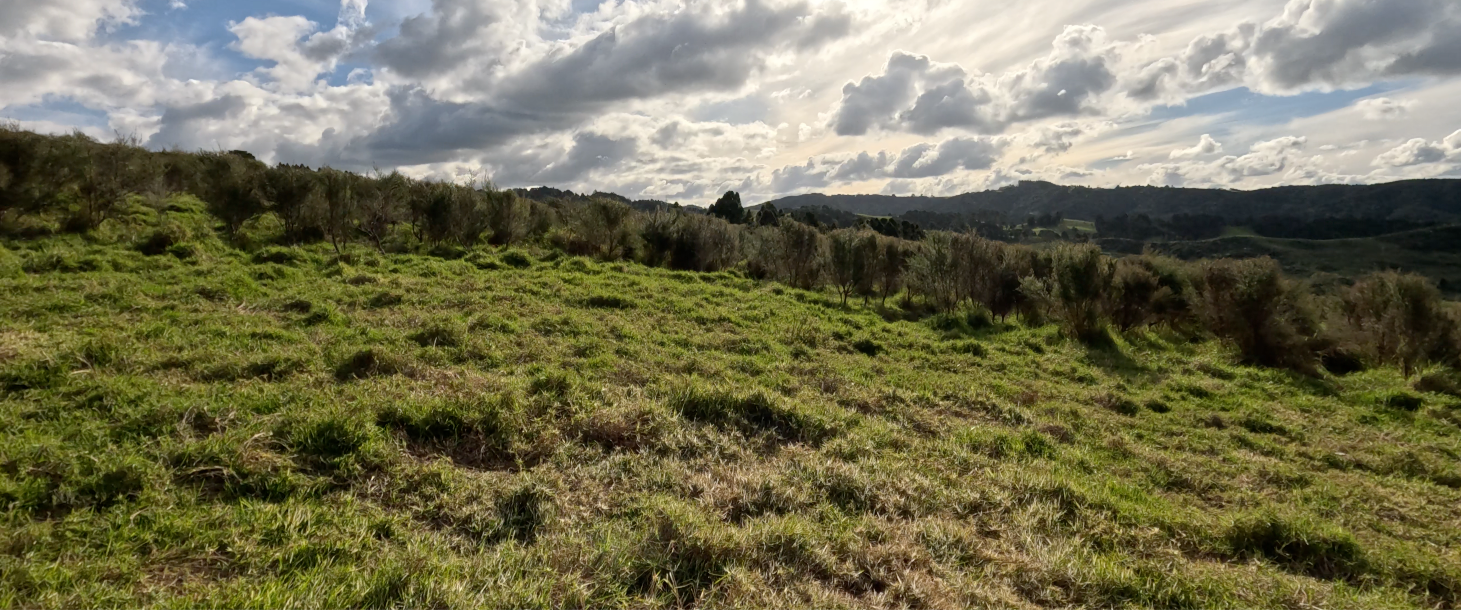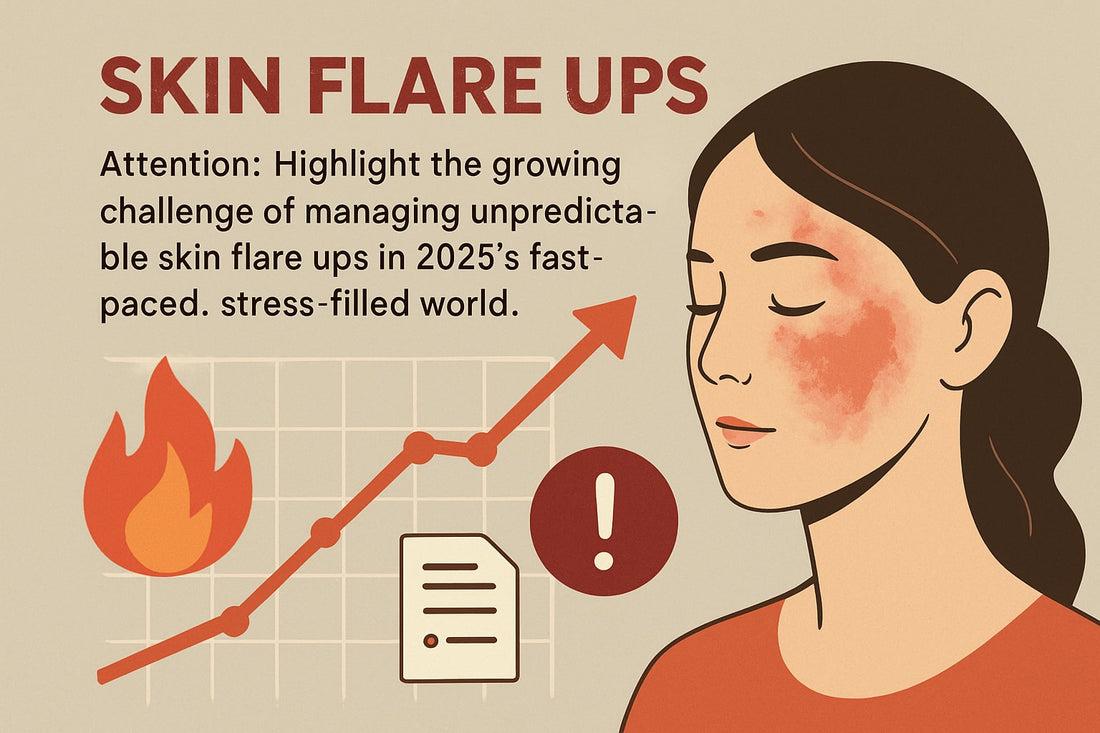
Skin Flare Ups Guide: Your Essential Handbook for 2025
In 2025, managing unpredictable skin flare ups is more challenging than ever. Our lives move at lightning speed, stress levels are high, and new environmental factors keep emerging. Many of us know the frustration of waking up to sudden redness, itching, or discomfort that can disrupt our day and knock our confidence.
These skin flare ups do more than affect the surface. They can impact your mood, self-esteem, and even your relationships. When your skin feels out of control, it’s easy to feel helpless.
That’s why having a trustworthy, science-backed guide is so important. Understanding, preventing, and treating skin flare ups requires up-to-date advice you can rely on.
This article is your essential handbook. We’ll walk you through recognising triggers, managing symptoms, and choosing the most effective solutions for skin flare ups in 2025. You’ll discover the causes, common types, modern treatments, daily prevention strategies, and natural options—so you can take back control of your skin and your wellbeing.
Understanding Skin Flare Ups: Causes and Triggers
Everyday life in 2025 can feel like an obstacle course for your skin. If you’ve ever experienced sudden itching, redness, or discomfort, you’re not alone. Understanding where skin flare ups come from is the first step to regaining control and confidence. Let’s break down what’s really happening beneath the surface.
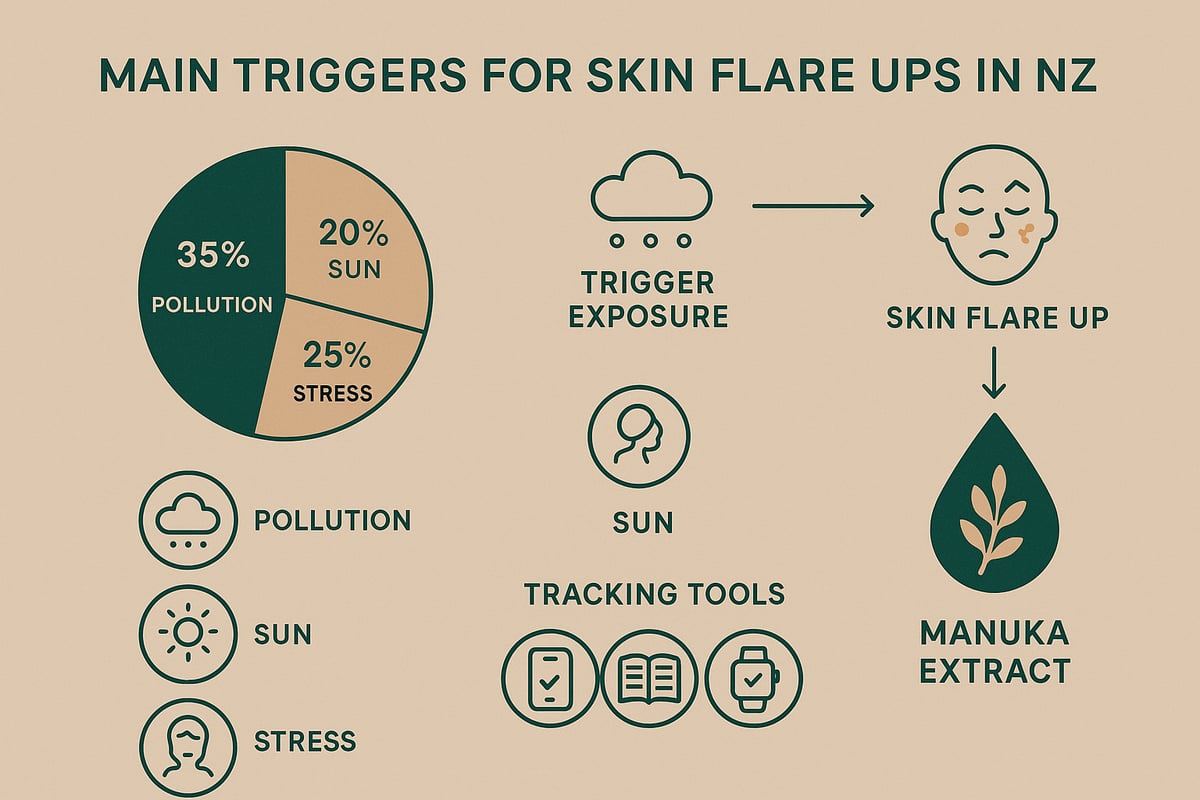
What Are Skin Flare Ups?
Skin flare ups are the sudden onset or rapid worsening of skin symptoms that can disrupt your day. These can be chronic, lasting for weeks or longer, or acute, appearing quickly and sometimes vanishing just as fast.
Common signs include redness, swelling, itching, and a burning sensation. Whether chronic or short-lived, skin flare ups can impact your comfort and confidence, making it important to know how and why they occur.
Key Triggers in 2025
The world is changing, and so are the triggers for skin flare ups. Environmental factors like increased pollution, fluctuating climate conditions, and stronger UV radiation are putting skin under new pressures.
Lifestyle habits are also evolving. More screen time, higher stress, disrupted sleep, and modern diets all contribute to a higher risk of skin flare ups. New chemicals in skincare and laundry products, often marketed as “advanced,” can act as hidden irritants. Allergens, both from the environment and from products, remain common culprits.
Underlying health conditions such as eczema, psoriasis, rosacea, and acne make the skin more sensitive to these triggers. Hormonal changes and certain medications can also set off skin flare ups, making personal awareness more important than ever.
Common Triggers Table
| Trigger Type | Example Sources | Impact on Skin |
|---|---|---|
| Environmental | Pollution, UV, weather | Irritation, inflammation |
| Lifestyle | Stress, diet, sleep | Barrier disruption, flare |
| Allergens/Irritants | Skincare, detergents | Rashes, itching |
| Health Conditions | Eczema, acne, psoriasis | Increased sensitivity |
| Medications/Hormones | Birth control, steroids | Fluctuating symptoms |
The Science Behind Flare Ups
Skin flare ups are rooted in the body’s immune system, which sometimes overreacts to perceived threats. This triggers inflammation, leading to the familiar discomfort.
A healthy skin barrier acts as your first line of defence, keeping out irritants and locking in moisture. When disrupted, the skin becomes more vulnerable to flare ups. The skin’s microbiome—its community of friendly bacteria—also plays a key role in maintaining balance.
Recent research from 2023 and 2024 shows that city living and extended digital device use, especially in New Zealand’s urban centres, can increase the frequency of skin flare ups. Blue light from screens and indoor air pollution are now recognised as significant contributors, making modern lifestyle choices more important to monitor than ever.
Recognising Your Personal Triggers
Identifying what sets off your skin flare ups is empowering. Start with a skin diary, jotting down what you eat, your stress levels, and any new products you use. There are also apps and wearable tech that track flare ups, helping you spot patterns over time.
For example, a New Zealand resident noticed that flare ups often followed high-stress days at work. By using a combination of journaling and data from a smartwatch, they were able to pinpoint stress as a major trigger. If you’d like inspiration, My Experience: Flare Up Diary shares a detailed journey of tracking and understanding personal skin triggers.
With the right tools and a little patience, you can uncover the unique causes of your skin flare ups and take meaningful steps toward clearer, calmer skin.
Common Types of Skin Flare Ups in 2025
The world of skin flare ups is vast and varied, impacting Kiwis of every age. Understanding the most common types can help you quickly spot symptoms, recognise patterns, and take action. Each type has its own set of triggers, challenges, and effective solutions, including innovative natural remedies like full spectrum Mānuka extract.
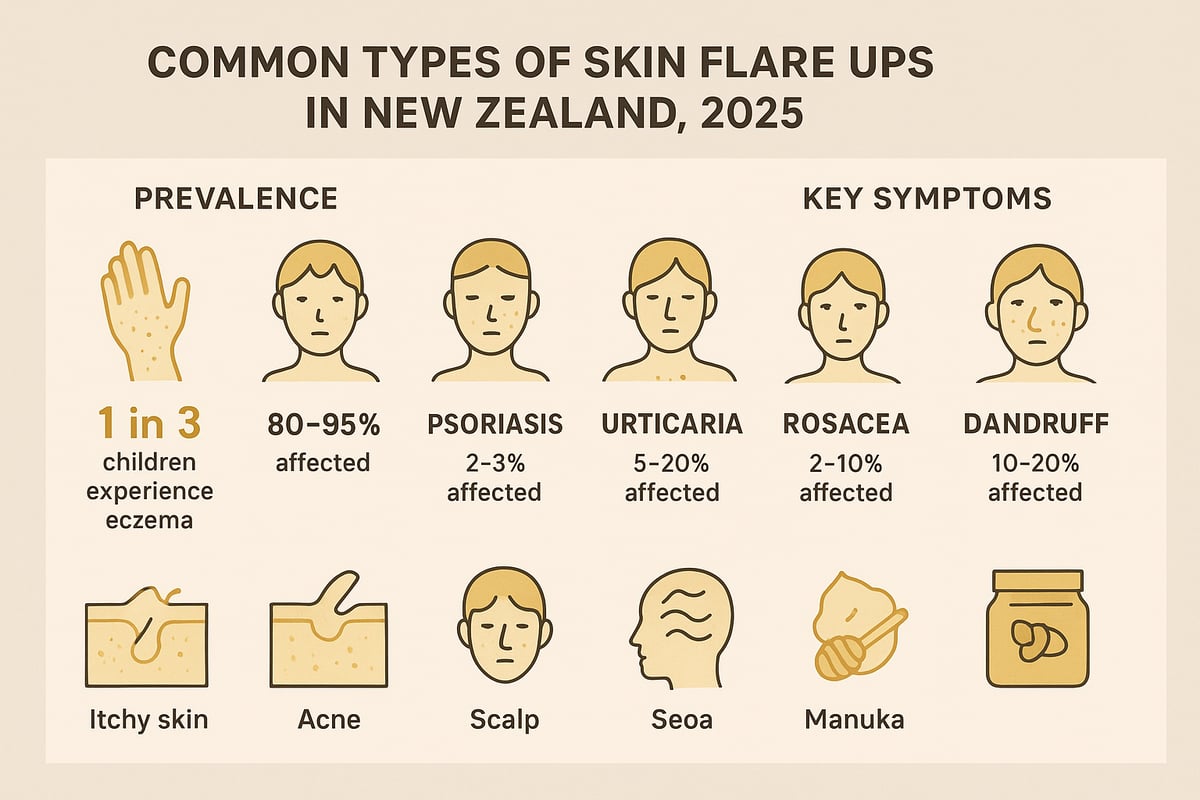
Eczema and Dermatitis
Eczema and dermatitis are among the most frequent skin flare ups in New Zealand, with around 1 in 3 children experiencing symptoms. These conditions cause dry, itchy, and inflamed patches that can disrupt daily life. Weather changes, harsh soaps, and synthetic fabrics often trigger flare ups. Many families are turning to natural options like Mānuka extract for gentle relief. For more practical tips, see Clearing Eczema Naturally.
Acne and Hormonal Breakouts
Adult acne is becoming more common, especially for women aged 25 to 45. Mask-related skin flare ups, or "maskne," remain a concern even post-pandemic. Hormonal cycles and diet shifts can spark sudden breakouts. Keeping a consistent skincare routine and seeking soothing ingredients like Mānuka can help manage these persistent flare ups.
Psoriasis and Chronic Inflammation
Psoriasis is an autoimmune-driven skin condition, affecting 2 to 3 percent of the NZ population. It appears as thick, scaly plaques and can be accompanied by joint pain. Stress, infections, and certain medications may trigger these skin flare ups. Mānuka extract’s anti-inflammatory properties offer a promising natural support for calming symptoms and supporting the skin barrier.
Urticaria (Hives) and Allergic Reactions
Urticaria, or hives, are sudden, itchy welts that can appear anywhere on the body. Foods, medications, or emotional stress are common triggers for these skin flare ups. Quick identification and gentle, soothing care are crucial. Natural options, including Mānuka-based creams, are gaining traction for their calming effects.
Rosacea and Facial Redness
Rosacea mostly affects fair-skinned adults, causing persistent facial redness and visible blood vessels. Triggers include spicy foods, alcohol, temperature changes, and stress. These skin flare ups can impact confidence, but targeted skincare and natural anti-inflammatories like Mānuka extract provide gentle support for sensitive faces.
Dandruff and Scalp Flare Ups
Dandruff and scalp skin flare ups often result from fungal imbalances, stress, or harsh haircare products. Symptoms include flaking and itchiness. Mānuka extract (Boost Blend), with its antimicrobial benefits, is increasingly recommended for soothing the scalp and restoring balance.
Innovations and Treatments for Flare Ups in 2025
Staying ahead of skin flare ups in 2025 means understanding the latest breakthroughs, natural remedies, and smart technology. Let’s explore how modern science and New Zealand’s botanical heritage are shaping a new era in skin care.
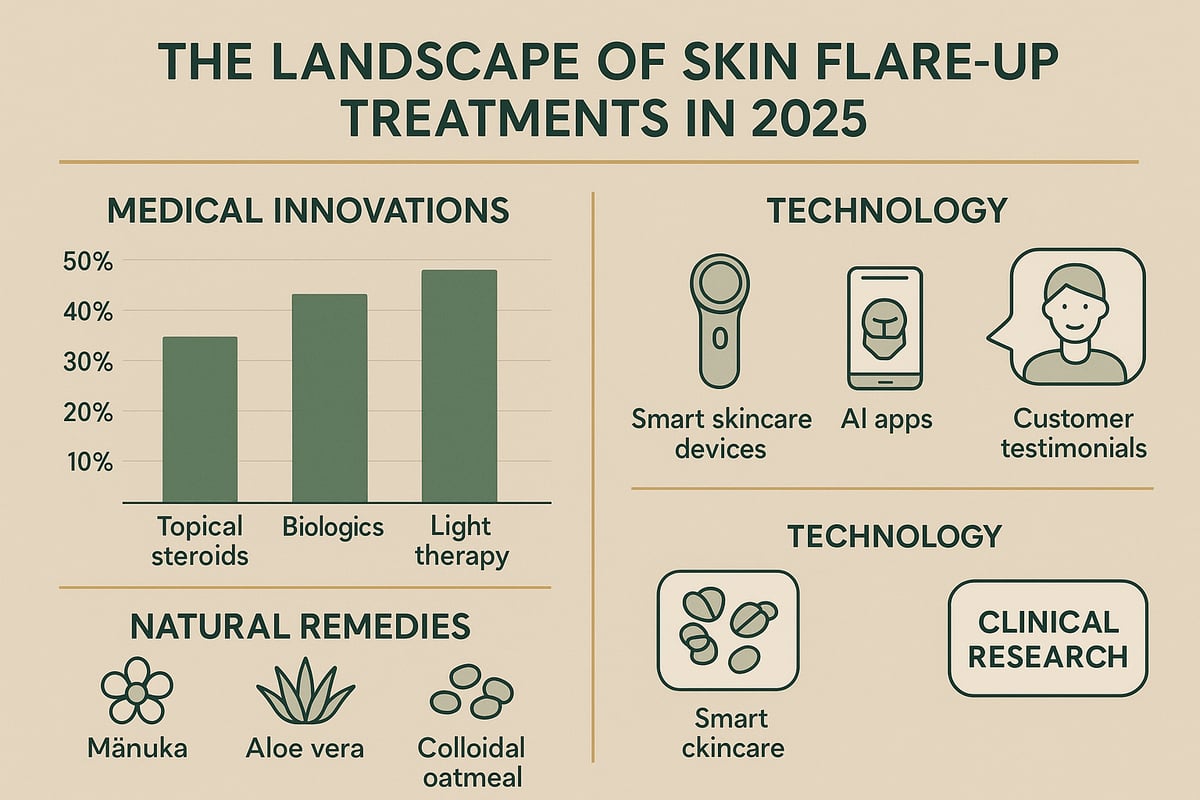
Medical Treatments: What’s New?
Medical science has rapidly evolved to offer more targeted solutions for skin flare ups. In 2025, dermatologists have access to advanced topical steroids that offer faster relief with fewer side effects. Calcineurin inhibitors are now available in gentler formulations, suitable for sensitive skin and long-term use.
For severe cases, biologic therapies and immunomodulators are changing the game. These treatments work by calming the immune system’s overreaction, reducing chronic inflammation. Light therapy and laser treatments are also gaining traction, delivering precise care for stubborn symptoms.
Teledermatology, powered by AI, allows New Zealanders to access skin specialists remotely. High-resolution imaging and instant analysis make it possible to get a personalised plan from the comfort of home. For a deeper dive into the latest breakthroughs, see Advancements in Eczema Treatment 2025.
Natural and Alternative Solutions
With more people seeking gentle, steroid-free options for skin flare ups, natural remedies are in demand. Plant-based ingredients such as colloidal oatmeal, aloe vera, calendula and Kawakawa are popular for their soothing and anti-inflammatory effects.
It’s essential to patch test new products and consult a professional before starting any alternative treatment. Many New Zealanders are turning to blends that combine traditional wisdom with modern science, ensuring both safety and efficacy.
Look for products that are fragrance-free and formulated for sensitive skin, especially if you’re managing ongoing flare ups.
The Role of Full Spectrum Mānuka Extract
New Zealand’s mānuka plant is at the forefront of natural innovation for skin flare ups. Full spectrum mānuka extract, such as that developed by Waipu Extracts, uses a state-of-the-art extraction process to preserve all bioactive compounds. This results in a potent, multi-action remedy.
Benefits include:
- Soothing inflammation and calming itchy, red skin
- Supporting the skin barrier and microbiome
- Promoting faster healing for eczema, acne, and dandruff
Customer testimonials highlight the gentle effectiveness of products like Hyper Blend and Boost Blend, which are tailored for eczema, dermatitis, and scalp health. Early clinical research supports mānuka’s antimicrobial and anti-inflammatory properties, making it a trusted choice for those seeking a natural, steroid-free solution.
Technology in Skin Care
Technology is transforming how we manage skin flare ups in 2025. Smart skincare devices now track hydration levels and UV exposure in real time, helping users make informed daily decisions.
AI-powered apps offer personalised product recommendations based on your skin’s unique needs and response patterns. These tools make it easier to prevent and treat flare ups before they escalate.
The combination of science, nature, and technology means New Zealanders have more control and confidence over their skin health than ever before.
Step-by-Step Guide: Managing and Preventing Flare Ups
Living with skin flare ups can feel like a never-ending quest for calm, but a structured approach puts you back in control. Here’s a clear, five-step guide to help you manage and prevent flare ups in your daily routine, using a blend of science, technology, and natural solutions.
![]()
Step 1: Identify and Track Triggers
The journey to fewer skin flare ups starts with understanding your own unique triggers. Keep a daily skin diary and jot down changes in weather, diet, stress, and new products. Digital apps and wearable tech make it easy to spot patterns, helping you predict and prevent future issues.
Notice a flare up after a late night or a new laundry detergent? Recording these details helps pinpoint connections. Over time, this knowledge empowers you to make smarter choices, reducing the frequency and severity of skin flare ups.
Step 2: Immediate Response to Flare Ups
When skin flare ups strike, early intervention is key. Start with gentle cleansing, using lukewarm water and fragrance-free products. Avoid scrubbing or hot showers, which can worsen irritation. A cool compress can help soothe itching and redness, while over-the-counter anti-itch creams offer quick relief.
If your symptoms worsen rapidly, cover large areas, or involve swelling around the eyes or mouth, it’s time to seek medical advice. Acting quickly gives your skin the best chance to recover and prevents flare ups from spiralling out of control.
Step 3: Choosing the Right Treatment
Choosing the best treatment for skin flare ups depends on severity and personal preference. For mild to moderate cases, fragrance-free moisturisers and natural options like full spectrum Mānuka extract can be soothing. This New Zealand botanical powerhouse is known for calming redness, restoring the skin barrier, and supporting healing.
For a deeper dive into triggers and therapies, explore the Understanding Eczema Triggers and Treatments guide.
Step 4: Daily Prevention Habits
Prevention is your daily shield against skin flare ups. Moisturise morning and night with products rich in ceramides or colloidal oatmeal. Choose protective clothing and broad-spectrum SPF to shield delicate skin from UV and pollution.
Stress is a sneaky trigger, so add mindfulness or breathing exercises to your routine. Prioritise sleep hygiene and gentle self-care rituals. These habits build your skin’s resilience, making flare ups less likely to disrupt your life.
Step 5: Long-Term Lifestyle Modifications
Sustainable change is the secret to fewer skin flare ups. Embrace an anti-inflammatory diet with omega-3s, antioxidants, and probiotics. Reduce exposure to known triggers by using air purifiers and switching to gentle, fragrance-free detergents.
Schedule regular skin check-ins and revisit your routine as seasons or life circumstances shift. For those struggling with scalp or facial flare ups, the Dermatitis and Dandruff Connection article offers extra guidance on managing these common issues. Consistency over time is what keeps flare ups at bay and your confidence strong.
Everyday Living with Sensitive Skin: Tips for 2025
Living with sensitive skin in 2025 means being proactive, informed, and gentle with your choices. The right habits and support can make all the difference in keeping skin flare ups at bay while boosting your confidence and overall wellbeing.
Building a Flare Up-Friendly Skincare Routine
A gentle, consistent routine is your first defence against skin flare ups. Start with a mild cleanser, followed by a hydrating serum and a barrier-supporting moisturiser. Always finish with SPF, even on cloudy days.
When choosing products, look for those free from alcohol, sulphates, and parabens. Many people find relief using natural solutions like full spectrum Mānuka extract, which soothes irritation and supports healing. If you experience flare ups in sensitive areas, such as the brows, the Eczema in Eyebrows Guide offers expert tips for targeted care.
Navigating Social and Emotional Impacts
Skin flare ups can affect more than just your skin—they can impact your social life and self-esteem. It is normal to feel self-conscious or frustrated during a flare, especially when symptoms are visible.
Building a supportive network, whether through friends, family, or online communities, helps ease the emotional load. Mindfulness, gentle exercise, and speaking to a mental health professional can also support your wellbeing. Remember, you are not alone in managing skin flare ups and there are resources to help you thrive.
Skin Health for Different Life Stages
Every age brings new challenges for skin flare ups. Children need fragrance-free, ultra-gentle routines to protect delicate skin. Teens often deal with hormonal changes and acne, so a balanced approach with non-comedogenic products is key.
Adults may notice flare ups triggered by stress or environmental changes. Prioritise barrier repair, hydration, and stress management. Across all life stages, incorporating nurturing botanicals like Mānuka extract supports resilience and recovery.
NZ-Specific Advice and Resources
New Zealanders face unique skin flare ups triggers, from variable weather to regional allergens. Access to dermatologists and local support groups can be a game changer for chronic flare ups.
For targeted solutions, many Kiwi families are turning to products made with full spectrum Mānuka extract, praised for its effectiveness and gentle care. Local pharmacies and trusted online stores provide options tailored to NZ’s needs. Community campaigns raise awareness, and prevalence rates show that sensitive skin is a widespread concern in our country.
| Condition | NZ Prevalence | Global Rate |
|---|---|---|
| Eczema | 1 in 3 kids | 1 in 5 kids |
| Psoriasis | 2-3% | 2% |
| Acne | 85% teens | 80% teens |
Future Trends in Skin Flare Up Management
Looking ahead, personalised medicine and DNA-based skincare are set to revolutionise how we manage skin flare ups. Eco-friendly, sustainable products are gaining traction as people seek natural solutions.
Telehealth and smart devices will make monitoring and managing skin flare ups easier than ever, putting control back in your hands.
We all know how tough it can be to manage unpredictable skin flare ups, especially with everything life throws at us these days. If you’re looking for a gentle, effective way to support your skin—without harsh chemicals or steroids—you’re not alone. That’s why I’m so passionate about the power of full spectrum Mānuka extract. It’s natural, packed with proven benefits for things like eczema, acne, and scalp flare ups, and it’s made right here in New Zealand by people who truly care about skin health. If you’re ready to try a science backed, compassionate solution, Get Your Mānuka Extract Today.

